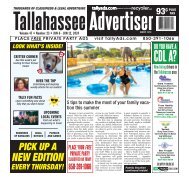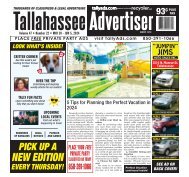You also want an ePaper? Increase the reach of your titles
YUMPU automatically turns print PDFs into web optimized ePapers that Google loves.
Business<br />
January 15-31, 2021 • 17<br />
Freight levels and pricing continue to climb, but hazards exist<br />
Cliff Abbott<br />
cliffa@thetruckermedia.com<br />
November freight levels remained strong<br />
as 2020 entered its final month. The American<br />
Trucking Associations (ATA) reported that its<br />
For-Hire Trucking Index increased 3.7% in<br />
November, earning back some of the 5% loss<br />
in October.<br />
The November index of 112.2 was 3.8%<br />
lower than November 2019, but was strong,<br />
nonetheless.<br />
“The 2020 seesaw pattern continued in<br />
November, as typical seasonality is not holding<br />
this year,” explained Bob Costello, chief<br />
economist for ATA. “It was a nice gain, but the<br />
rebound was not enough to make up for October’s<br />
drop.”<br />
ATA’s numbers are compiled from data<br />
submitted by members of the organization,<br />
which tend to be larger carriers with a high<br />
percentage of contract freight from manufacturing<br />
customers. In an economy where shipments<br />
of retail goods have been higher than<br />
normal while manufactured goods haven’t<br />
fully recovered, carriers with a large percentage<br />
of manufacturing customers can experience<br />
sporadic freight levels.<br />
The Cass Freight Index for shipments,<br />
which tracks shipments in multiple modes<br />
of transportation, declined 2.2% in November<br />
from its October level. Compared to November<br />
2019 however, shipments increased<br />
by 2.7%. The Cass Index includes shipments<br />
by rail, pipeline, ship and barge, trucking and<br />
other modes.<br />
In a statement announcing the decline, Cass<br />
noted that the November decline “followed five<br />
consecutive months of strong recovery averaging<br />
5.0% sequential improvement (seasonally<br />
adjusted), and is likely due to the worsening<br />
pandemic numbers impacting the trajectory of<br />
the recovery in November.”<br />
Rising COVID-19 numbers might impact<br />
some shipping segments more than others.<br />
While people are quarantined at home, they<br />
can still be ordering retail goods online. The<br />
Cass statement noted that shipments in the<br />
less-than-truckload (LTL) sector increased for<br />
three consecutive months, including a 6.0%<br />
increase in November compared to November<br />
of 2019.<br />
Spot freight rates, which are more volatile<br />
than contract rates, tend to react quickly to<br />
market changes. Spot rates have been on the<br />
rise for months and set new records in November.<br />
Van rates rose to an average of $2.46<br />
per mile, while flatbed rates averaged $2.47.<br />
Rates for refrigerated freight dropped a penny<br />
from October’s high, averaging $2.68 per mile.<br />
That’s more likely a seasonal impact, since<br />
refrigerated rates often rise and fall with the<br />
availability of fresh produce.<br />
Overall, spot rates continued strong into<br />
December, and both spot and contract rates are<br />
expected to strengthen into the new year. This<br />
time, however, there are more variables than<br />
usually faced by the industry.<br />
One of the largest variables is the<br />
COVID-19 pandemic.<br />
As November drew to a close, record numbers<br />
of positive COVID-19 tests were being<br />
reported, hospitals reported overcrowding, and<br />
pundits warned of still larger numbers of infections<br />
to come. At the same time, vaccinations<br />
became available in December, with medical<br />
personnel and first responders among the first<br />
to receive shots.<br />
It will undoubtedly take months to distribute<br />
the vaccine to everyone — and many people<br />
have expressed resistance to being vaccinated.<br />
The question of when the country will achieve<br />
“herd immunity” is up for debate, and scientists<br />
disagree on the percentage of the population<br />
that must be vaccinated to stop the virus.<br />
AP Photo/Morry Gash<br />
It will undoubtedly take months to distribute the COVID-19 vaccine to everyone. It may be deemed<br />
necessary to shut the economy down again while the vaccine that would allow reopening is being<br />
distributed, which would certainly affect freight rates and levels. Shown above, boxes containing<br />
the Pfizer-BioNTech COVID-19 vaccine are being prepared to be shipped from the Pfizer Global<br />
Supply Kalamazoo manufacturing plant in mid-December.<br />
In the meantime, positive COVID-19<br />
cases continue growing. President-elect Joe<br />
Biden has indicated that federally mandated<br />
restrictions, including a mask mandate,<br />
could be in store once he takes office Jan. 20.<br />
It may be deemed necessary to shut the<br />
economy down again while the vaccine that<br />
would allow reopening is being distributed.<br />
Another issue affecting freight levels is<br />
inventory. According to a Jan. 4 blog post by<br />
FTR’s Steve Graham, increases in sales have<br />
brought business inventories down, creating<br />
a need for more production. That’s good for<br />
See Hazards on p18 m<br />
Arizona DOT converts to cashless permitting system for commercial trucks<br />
iStock Photo<br />
Beginning Jan. 21, Arizona’s ports of entry will convert to a fully cashless permitting<br />
system.<br />
THE TRUCKER NEWS SERVICES<br />
PHOENIX — Effective Jan. 21, the<br />
Arizona Department of Transportation’s<br />
(ADOT) ports of entry will convert to a<br />
fully cashless system. The change comes after<br />
ADOT successfully implemented a pilot<br />
program, preparing trucking companies that<br />
currently pay with cash to make the move to<br />
a cashless system.<br />
According to a statement issued by<br />
ADOT, when commercial truckers purchase<br />
their permits for driving through Arizona online<br />
ahead of time or use a cashless method<br />
at the port of entry, they spend less time making<br />
payments and get on their way faster.<br />
The move to end the acceptance of cash and<br />
checks at ports of entry also supports recommendations<br />
by the U.S. Centers for Disease<br />
Control and Prevention (CDC) to curb the<br />
spread of COVID-19 through the exchange<br />
of currency.<br />
ADOT’s truck-permitting systems, ePro<br />
and Transport, have cashless features that<br />
are used by nearly 80% of truckers. To help<br />
trucks move through the ports more efficiently,<br />
ADOT’s Enforcement and Compliance<br />
Division used the pilot-program period<br />
to convince the remaining 20% to pay for<br />
permits online using Apple Pay, Android Pay<br />
or a credit card.<br />
“We have been getting a feel from the<br />
trucking industry on how much they would<br />
support this change, and the feedback has<br />
been positive,” said Lt. Jason Sloan, team<br />
lead for implementing the change. “This<br />
improvement will help eliminate waste and<br />
maximize resources available at ports of<br />
See Cashless on p18 m

















